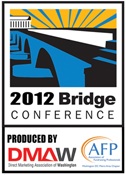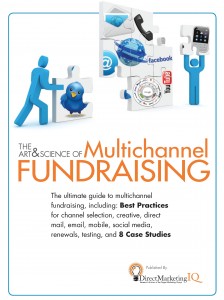Recently I attended the DMAW’s monthly luncheon where a packed house turned out to hear Roger Craver, Founder of DonorTrends and editor of The Agitator, share his insights on integrating year end campaigns.
For most, one big lesson had to be this: when Roger Craver’s speaking, you can’t afford to miss it. But in case you did, here are a few words of wisdom from Roger to keep in mind for your year-end campaigns that I shared in a guest post for the DMAW’s blog …
Multichannel communications are critical to successful fundraising.
You’ve probably heard this one before. But Roger presented the data to prove why multichannel communications are essential to keeping your donors …
- Direct mail donors who have an email address on file are 150% more valuable than direct mail donors without an email on file.
- Email addresses shorten the time to achieving a second gift … and more than double the retention rates of one-time first year givers.
- An SMS message following a solicitation can increase renewal rates by 25%.
- Donors with email addresses give 50% more gifts per donor, and have an average gift that is 67% higher.
If you haven’t yet, it’s time to create a budget for acquiring your donors’ email addresses, mobile numbers and more. A little investment can have a huge impact on your retention rates.
Your donor has changed – and it’s your job to understand what they need.
Younger donors don’t behave like the generation that came before. Donors have changed from a “tell me” generation to a “show me” generation that expects organizations to show them the impact of their support with photos, stories, videos, conference calls and more. And donors expect you to listen to them and to hear their advice, concerns and opinions on your organization and your issues.
Fortunately, new communication channels are perfectly suited to engaging donors in dialogue … and an organization’s ability to retain its donors will increasingly depend on its ability to do just that.
To create strong, multichannel efforts, organizations have to change how they work.
Good multichannel communications aren’t the sole responsibility of one department. Break down silos with interdepartmental teams empowered to create effective, multichannel campaigns. Also …
- Follow the 75% rule. New channels won’t wait around while you craft the perfect tweet. Accept communications that are 75% perfect and 100% on time.
- Understand the ROI of each channel. Even when creating a multichannel campaign, be sure that you focus most of your time and energy on channels that have the greatest return on investment.
New technology allows us to go back to old ways of fundraising.
Classic fundraising techniques still work better than anything else. 50% of donors say they were motivated to give because “a friend asked,” and fundraising emails sent by a friend have open rates of 90% (compare that to your last campaign!).
Use new channels to make your campaigns more personal, more timely, and more direct – all the elements that have always led to successful fundraising.
Do you have other great stats on the value of multichannel campaigns – or tips on smart, year-end strategies? We’d love to hear them!
 The Bridge Conference, one of the must-attend conferences on integrated nonprofit fundraising and communications, kicks off on Wednesday, August 8. The annual gathering co-produced by the DMAW and the DC Chapter of the AFP brings together 1,400+ people who share a common interest in stellar nonprofit marketing, fundraising and communications. If you haven’t already registered, you still can.
The Bridge Conference, one of the must-attend conferences on integrated nonprofit fundraising and communications, kicks off on Wednesday, August 8. The annual gathering co-produced by the DMAW and the DC Chapter of the AFP brings together 1,400+ people who share a common interest in stellar nonprofit marketing, fundraising and communications. If you haven’t already registered, you still can.










